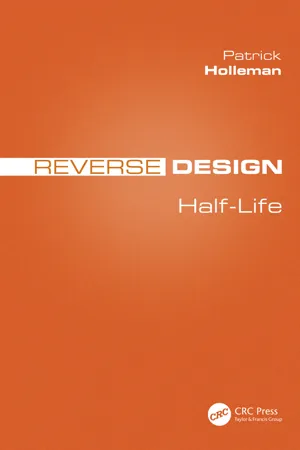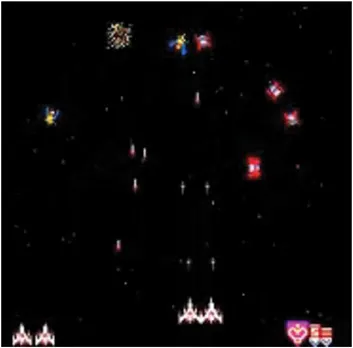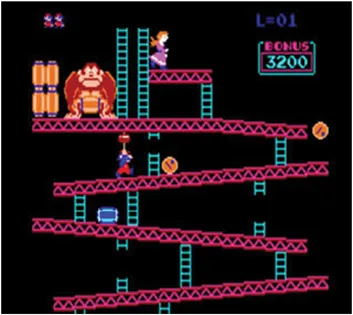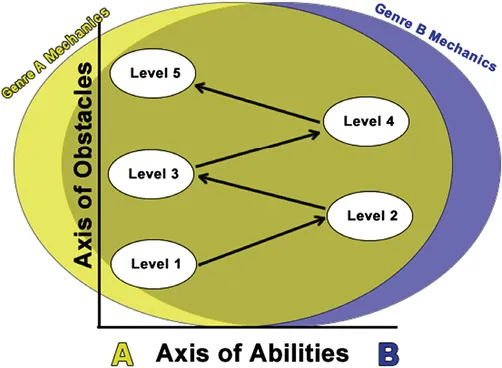
This is a test
- 188 pages
- English
- ePUB (mobile friendly)
- Available on iOS & Android
eBook - ePub
Book details
Book preview
Table of contents
Citations
About This Book
The Reverse Design series looks at all of the design decisions that went into classic video games. This is the fourth installment in the Reverse Design series, looking at Half Life. Written in a readable format, it is broken down into six sections examining some of the most important topics to the game:
- How Half-Life is a key step in the evolution from the composite style of videogame design to the set piece style of design.
- How Half-Life defined almost all of the core concepts of the cover-based shooter, and redefined the level architecture of the FPS genre
- The small tricks and flourishes that Half-Life used to tell a story through its mechanics, AI and environments
Key Features
- Comprehensive definitions of key concepts and terms, introducing the reader to the basic knowledge about the study of FPS design
- Summary of historical context of Half-Life, how it emerged from arena shooters like Doom and Quake, and how it influenced other games
- Extensive collections of data and data visualizations explaining how systems like enemy movement, cover design and platformer physics work
Frequently asked questions
At the moment all of our mobile-responsive ePub books are available to download via the app. Most of our PDFs are also available to download and we're working on making the final remaining ones downloadable now. Learn more here.
Both plans give you full access to the library and all of Perlego’s features. The only differences are the price and subscription period: With the annual plan you’ll save around 30% compared to 12 months on the monthly plan.
We are an online textbook subscription service, where you can get access to an entire online library for less than the price of a single book per month. With over 1 million books across 1000+ topics, we’ve got you covered! Learn more here.
Look out for the read-aloud symbol on your next book to see if you can listen to it. The read-aloud tool reads text aloud for you, highlighting the text as it is being read. You can pause it, speed it up and slow it down. Learn more here.
Yes, you can access Reverse Design by Patrick Holleman in PDF and/or ePUB format, as well as other popular books in Computer Science & Programming Games. We have over one million books available in our catalogue for you to explore.
Information
1
Half-Life and the History of Videogame Design
Nishikado Motion and the Arcade Era
Genre Creation in the Composite Period
The Vocabulary of Cover
The Earliest Cover
The FPS Beginnings
Big Advances: Quake and Quake 2
The Structure of Half-Life
A Note on Mechanics
Through the Reverse Design series and other documents, we have already set forward the overall history of videogame design several times. Therefore, for this summary I will try to be as brief and as specific to Half-Life as possible about the overall history of games. We will go into great depth about the history of the FPS, however, because of how relevant it is to Half-Life’s design. For a more in-depth look, I suggest looking at the first few sections of Reverse Design: Super Mario World, which covers the composite era in greater depth. That said, it isn’t necessary to read it to understand this book; a synopsis follows just below. At any rate, this book focuses primarily on the transition from the composite era into the set piece era, and how that was an inevitable consequence of the collision of Western development techniques with Japanese game design styles. Half-Life straddles the composite and set piece eras in a significant way, and so it makes for a great example of the third great inflection point in videogame design history.
Nishikado Motion and the Arcade Era
The history of videogame design, as we understand the field today, began in 1978 with the game Space Invaders. Obviously, videogames had been invented before this, but Space Invaders was the first game to demonstrate the core principle of videogame design. The designer of Space Invaders, Tomohiro Nishikado, was also the lead engineer responsible for building the physical components of the arcade machine. Because of an unexpected property of the processor he used for the game, the ranks of enemies (the “space invaders” themselves) moved progressively faster as the player cleared the level of them. This meant that every level would get progressively harder toward the end, and then the difficulty would drop off considerably when the next level started. Although this was accidental, Nishikado kept this feature in the game and then embellished it by making the beginning of each level successively (but only slightly) more difficult. I have visualized the difficulty of the game just below.

The regular up-and-down motion of the game’s difficulty is what I call Nishikado motion. Other designers and writers have sometimes referred to this as a “series of ascending arcs,” which is a fine term as well, but I’ll be using the former term throughout the rest of this chapter (in this book).
In the first few years after the discovery of Nishikado motion, there were two primary ways that designers implemented it in their games. First, designers could change the numbers, strength, and timing of their enemies or obstacles. In Space Invaders, Nishikado accidentally changed the timing elements of the enemies; they moved faster when there were fewer of them. As the player gets through a level of Asteroids (1979), the asteroids themselves become more numerous and move faster. In Missile Command (1980), the missiles fall more rapidly and there are more of them as the player gets deeper into the game. The invention of the powerup added a second means of causing the difficulty to rise and fall, however. In games like Phoenix, Galaga, or Pac-Man, the player periodically gained powerups that made the game easier. For example, in Galaga, the multi-ship powerup doubled the player’s firepower.

These powerups really just accomplished the same thing as changes in the number, strength, and timing of enemies or obstacles. For instance, in Galaga it’s obvious that the designers were simply increasing the ship’s shooting ability numerically by doubling it. It’s not that different than if the developers were to simply cut the number of enemies by a large fraction. In Pac-Man, it’s less obvious, but still essentially the same design idea. Over time, the duration of the energizer powerup gradually diminishes while the enemies only grow in difficulty. Again, this is just a change in difficulty variables from another source.
Another more important way of using powerups arose in the work of Shigeru Miyamoto. While most of the games of the early 80s used powerups as a back door into controlling difficulty, Miyamoto’s first game—Donkey Kong—did something very different. When Jump Man (Mario’s first incarnation) gains the Hammer powerup in Donkey Kong, he loses the ability to jump, but gains the ability to attack enemies. The game temporarily stops being a platformer and starts being an action game.


Instead of treating the powerups as another quantitative modifier of game difficulty, Donkey Kong’s powerup makes the gameplay change genres. In Donkey Kong, this was a very rudimentary idea and probably the product of serendipity rather than a clear plan, but Miyamoto and his team must have gotten the sense that moving between genres within a game would be the design style of the future. The great strength of a game that moved between genres (even if only in a small way) is that the game could present new challenges to the player without always getting quantitatively more difficult. The great weakness of arcade games was that they forced the player up an endless hill of quantitative increases in difficulty. As a result, those games lost many players who became frustrated before they could really get into the game.
In 1985, Miyamoto and his team took this idea to its logical conclusion and created the first real composite game, Super Mario Bros. A composite game is a game in which a player can use the mechanics of one genre to solve the problems of another genre. In Super Mario Bros, the player can use platforming mechanics (jumping with momentum) to solve action game problems (defeating or avoiding enemies). The secret of a composite game, though, is not just combining two genres, but rather moving between those two genres without ever abandoning either one. Each level in Super Mario Bros “declines” (literally, leans toward) one of the two composited genres while never ceasing to be a combination of both. In the screenshots below, you can probably guess whether the levels in question are in the platformer (lots of jumping) or action (more combat) declensions.

The back-and-forth motion between genres in the composite creates “composite flow.” This is a phenomenon similar to ordinary psychological flow in that the player becomes immersed in the task and forgets everything else. The unique feature of composite flow is that it is achieved by moving from one genre declension to the other just before the player gets bored or frustrated. All the while, however, the game is also getting more difficult. If you were to make a graph of it, it would look something like the figure you see below.

Nishikado motion is still the foundation of the composite game; it’s just incorporated into larger framework. In the figure above, the ebb and flow in difficulty typical of Nishikado motion is still visualized on the y-axis, or what I call the axis of obstacles. Now, we also add another axis that measures changes in genre, what I call the axis of abilities. Immediately after Super Mario Bros came out, videogame designers all over the world latched onto the idea of the composite game and started making their own combinations.
Genre Creation in the Composite Period
Composite design displaced the arcade style of design, and so we call the period from 1985 until about 1998 the composite period, after which point another game design style became equally popular. During this time, dozens of different composites flourished, and the practice of composite design advanced considerably. Designers created some truly great composite games through innovative combinations. Mega Man and Metroid both added shooting to platformers to great effect. Sonic the Hedgehog took the Action/Platformer composite of Super Mario Bros and added racing game...
Table of contents
- Cover
- Half Title
- Title Page
- Copyright Page
- Contents
- Introduction
- 1. Half-Life and the History of Videogame Design
- 2. The Cover Theme
- 3. The Platform Theme
- 4. The Arena Theme
- 5. Non-Theme Set Pieces and Selected Through Content
- 6. Half-Life Cover and Multiplayer Level Design
- 7. Conclusion
- Index